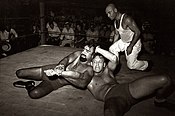All-in professional wrestling
| Part of a series on |
| Professional wrestling |
|---|
 |
All-in wrestling was both a style of
The term "All In" later became synonymous with more anarchic professional wrestling shows, leading to censure by local authorities by the late 1930s. Consequently, the "All In" label was disowned by most British wrestling promoters following the adoption of the 1947 Mountevans rules.[2] Nevertheless, the term still lingered for many years afterwards amongst the media and the public.
History
Professional wrestling in the
It was with this revival that the more
Amateur wrestler Sir Atholl Oakeley got together with fellow grappler Henry Irslinger to launch one of the first promotions to employ the new style of wrestling which was coined "All-in" wrestling. Though, like many wrestlers throughout the business, Oakley would claim his wrestling was entirely legitimate, his claim was highly dubious. According to Pro Wrestling Press, Under the British Wrestling Association banner, Oakley's promotion took off with wrestlers such as Tommy Mann, Black Butcher Johnson, Jack Pye, Norman the Butcher, College Boy, and Jack Sherry on the roster, while Oakley himself would win a series of matches to be crowned the first British Heavyweight Champion.[3]
The business was reaching one of its highest points at the time, with the best part of forty regular venues in
After the war, attempts to relaunch the business in 1947 failed to catch on with journalists who condemned the gimmickry calling the show fake. The revelation of this, and the general chaos which had surrounded All In Wrestling prior to the War, prompted
In popular culture
Despite the rejection of the name "All In" by British wrestling promoters, the term continued to be used in the UK to refer to professional wrestling - often in a derogatory sense by non-fans. An example of its use in this context is in the Monty Python's Flying Circus sketch "All In Cricket" which depicts two cricketers dueling with cricket bats in a wrestling ring.[7]
English translations of Mythologies by Roland Barthes have frequently rendered the French term Le Catch as All In wrestling, (despite Barthes having written the book in France in the 1950s).[8]
See also
References
- ^ Blue Blood On The Mat, Sir Atholl Oakeley, Summersdale Publishers Ltd 1994 edition
- ^ a b c The Wrestling, Simon Garfield, Faber & Faber 1996
- ISBN 978-1-4116-5329-0
- ^ Stead, R. Maillard (November 3, 1937). And Talking of..."Wrestling": 'All In' Wrestling--and Wrestling No "All In" Wrestling Professional Methods Mat-Work Does Not Fit Two Amateur Codes. The Christian Science Monitor
- ^ Staff report (January 9, 1938). "All In" Wrestling Condemned. The Age
- ^ Staff report (April 3, 1938). "All In" Wrestling. English Judge's Views. "Not A Sport." The Sydney Morning Herald
- ^ "Monty Python: Interesting People".
- ISBN 978-0-374-52150-9
